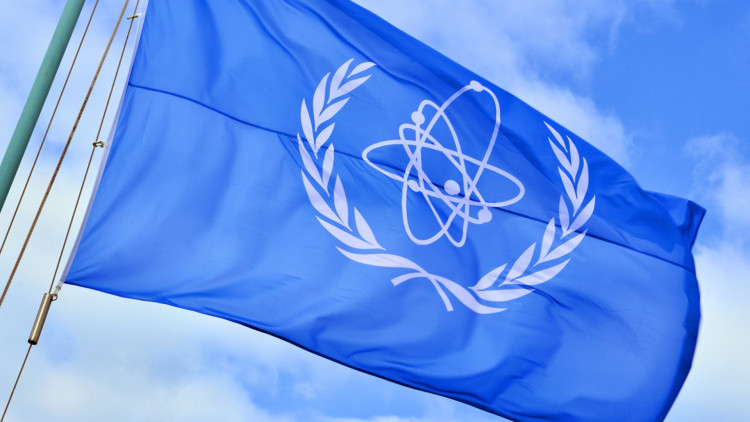An undated photo of the Zaporizhzhia nuclear power plant. (Photo: Ralf 1969)
The International Atomic Energy Agency team at Ukraine’s Zaporizhzhia nuclear power plant (ZNPP) reported hearing gunfire near the site this morning while a drone hit the plant’s training center.
In a news release today, IAEA director general Rafael Mariano Grossi said this is the third drone to target the training center, located just outside the site perimeter, so far this year. He called for an immediate end to drones being flown over or near nuclear facilities.
During a November 2024 mission, the IAEA delivered two new ambulances to Ukraine at the Chernobyl site. Varash Hospital director Tetiana Latyshenko is at left, with Liliana Salaru, IAEA senior medical officer, at right. (Photo: IAEA)
The United Nations' nuclear watchdog delivered emergency medical supplies to Ukraine last week as part of ongoing aid to the country since its conflict with Russia began in 2022.
Dealing with the aftermath of the Russian drone attack on the Chernobyl nuclear power plant. (Photo: State Emergency Service of Ukraine)
Ukraine’s State Emergency Service has finally gained full control over a blaze that started February 14 after a drone struck the protective dome over the destroyed reactor from the 1986 Chernobyl nuclear plant accident.
February 26, 2025, 9:30AMUpdated February 26, 2025, 9:30AMNuclear NewsEd Warman Ed Warman in 1990 (left), when he was named an ANS Fellow, and in 2019 (right) with a great-granddaughter, who is wearing a Soviet hat that was bought from a Russian soldier the day before the Red Army evacuated Prague in 1991.
We welcome ANS members with long careers in the community to submit their own stories so that the personal history of nuclear power can be capured. For information on submitting your stories, contact nucnews@ans.org.
When I graduated from Scranton University in 1956 with a B.S. in physics, I was in awe of the nuclear era and determined to be part of a nuclear future. Fortunately, I landed a position with Pratt & Whitney Aircraft as part of the Aircraft Nuclear Propulsion program. The position included a one-year assignment as a visiting staff member at Oak Ridge National Laboratory.
The New Safe Confinement over unit 4 at the Chernobyl nuclear power plant in 2017. (Photo: Tim Porter)
Social media this past weekend streamed with reactionary posts following a drone strike last Friday at the site of the destroyed reactor from the 1986 Chernobyl accident. The drone—armed with a warhead—ripped a hole in the New Safe Confinement (NSC), a large structure built to prevent any radioactive release from the damaged reactor unit 4 and to protect it from any external hazard. The drone strike caused a fire that was still smoldering in places as of Monday morning, and left a hole larger than 500 square feet. Efforts continue to mitigate the consequences of the fire and extinguish isolated smouldering areas of the NSC's insulation material.
Due to damage to the external and internal cladding of the NSC's arch and main crane system equipment, the safety boundaries and operational conditions of the NSC complex have been compromised, according to the Chernobyl nuclear power plant Facebook page.
The Rivne nuclear power plant in western Ukraine, home to four VVER pressurized water reactors. (Photo: Victor Korniyenko/Wikipedia)
In what it is calling a “major expansion” of its efforts to prevent a severe nuclear accident befalling Ukraine, the International Atomic Energy Agency yesterday announced that it is deploying teams of nuclear security and safety experts this week to the beleaguered nation’s nuclear power plants and the Chernobyl site. (The agency has already stationed a team of experts at Ukraine’s largest nuclear facility, the six-unit Zaporizhzhia plant, which has been under Russian military occupation since last March.)
Ukraine’s president, Volodymyr Zelensky, thanks IAEA director general Rafael Mariano Grossi for the agency’s support, including its April 26 mission to Chernobyl. (Photo: IAEA)
The director general of the International Atomic Energy Agency, Rafael Mariano Grossi, led a mission to Ukraine’s Chernobyl nuclear plant this week to address ongoing radiological safety concerns at the shuttered site following five weeks (February 24–March 31) of Russian military occupation.
A screen shot from the ANS webinar, “A Reactor Physicist’s Explanation of Chernobyl,” featuring Christopher Perfetti (inset). (Source: ANS)
On the 36th anniversary of the Chernobyl nuclear accident, the American Nuclear Society held the webinar, “A Reactor Physicist’s Explanation of Chernobyl,” led by Christopher Perfetti, an assistant professor in the Nuclear Engineering Department at the University of New Mexico. (Here we use the more common Russian spelling of Chernobyl, rather than the Ukrainian spelling, Chornobyl.)
















